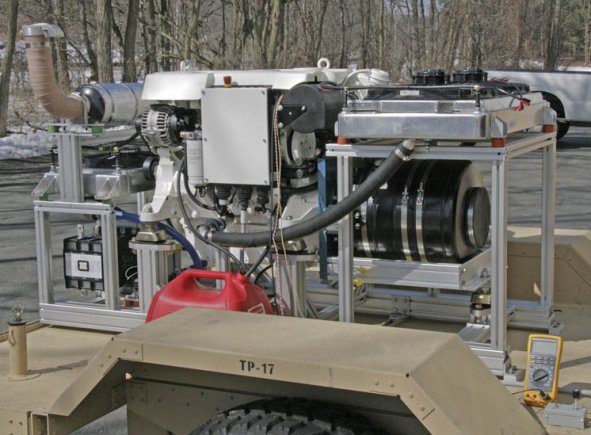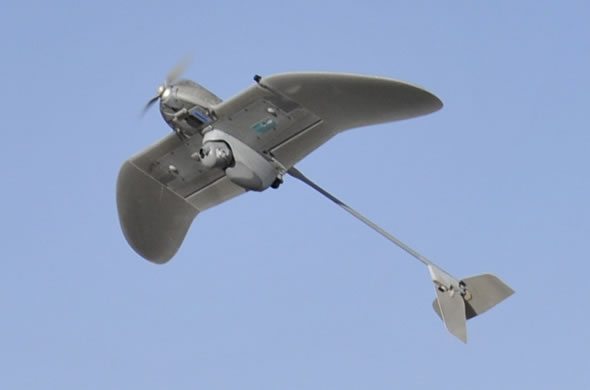U.S. Army engineers were recognized for their collaborative efforts with small business to develop a transportable 100 kW generator that is 3,150 pounds lighter than those currently in theater.
Members of the Research, Development & Engineering Command’s Communications-Electronics Research, Development and Engineering Center, or CERDEC, received an Army Small Business Innovation Research, or SBIR, Phase II Achievement Award at the Women’s Memorial Center, Arlington National Cemetery, April 26, for their work with Spectrum Research Corporation of Albany, N.Y.
The effort resulted in a generator light and compact enough to be towed by a Humvee, yet sturdy enough to be transported off road. The towable 100 kW is a load following, variable speed generator set; this potentially allows for a 20 percent fuel reduction and mitigates wet stacking, which is deposit buildup that clogs the exhaust system resulting in serious damage to the generator.
CERDEC’s Command, Power & Integration directorate managed the project, providing technical expertise and guidance to spectrum Research Corp. regarding Army field requirements. The research and development project represents a breakthrough capability for mobile tactical power applications that could be used to support command outposts and expeditionary camps, said Edmund A. Nawrocki, leader for CERDEC CP&I’s Advanced Electromechanical Team.
“Our goal was to improve fuel efficiency, reduce the weight and size, improve power quality and reduce the number of generator sets used in the field. This generator could support medical units, kitchens, command posts, base camps and disaster relief efforts. It’s plug-and-play, so it drastically reduces training time,” said Edmund A. Nawrocki, leader for CERDEC CP&I’s Advanced Electromechanical Team.
“This effort is highly innovative on many levels,” Nawrocki said. “It features a hybrid electric architecture that reduces strain on the engine — an energy storage subsystem that provides uninterruptable power until the engine catches up — the intelligent variable engine speed improves fuel conversion efficiency; and the electromechanical components will help extend mission times while reducing emissions. It will not only help reduce operational costs, but it will also translate to fewer Soldier casualties associated with fuel runs.”
Product Manager Force Sustainment Systems’ Force Provider hopes to evaluate the towable generator this summer during a demonstration at their Base Camp Integration Lab at Fort Devens, Mass. Force Provider is the Army’s base camp life support system, managed by PM FSS.
Responsible for setting up and powering Expeditionary Base Camps, PM FSS represents the largest single user of 60kW tactical quiet generators. The system is of interest because it could work well as a mobile and efficient power source for smaller base camps, combat outposts and stand-alone dining facilities, said William M. Singleton, lead engineer for Force Provider’s Combat Field Service Equipment Team.
“PM FSS would want to evaluate the performance, utility and suitablilty of this type of generator set in a realistic Forward Operating Base setting. Once we are contacted by CERDEC regarding possible dates and have received a formal test plan, we can schedule it in around other ongoing testing and training activities at the BCIL,” Singleton said.
“The variable speed, load-following capabilities allow the source power output to be matched closely to the varying loads encountered in operating combat support equipment, particularly the base camp equipment found in Force Provider. This can allow for significant fuel savings compared to mismatched sources and loads, as is often common on the battlefield today,” Singleton said.
Currently, PM FSS has no acquisition plans for this type of generator set. However, a successful test could lead to a re-evaluation of future requirements for power generation equipment in PM FSS systems, Singleton said.
The Army annually recognizes the most exceptional SBIR Phase II efforts which exemplify the SBIR goal of bringing innovative technologies and products to the marketplace. Award winners are selected based on the following criteria: originality and innovation of research; relevance of the research to the Army mission; immediate commercialization potential of the research, reflecting the primary goal of bringing technology and products to the marketplace; and overall quality performance of the project.
This is CERDEC CP&I’s third SBIR Achievement Award for power-related work in seven years. Four of the CP&I Power division’s SBIR-born designs have been transitioned to programs of record.
“Our job as an R&D organization is to find out what’s possible then provide that information back to Army leadership to use as they can make acquisition decisions. Sometimes we develop solutions internally, but other times we use our expertise and understanding of Army requirements to look at what solutions exist to see if they can be adopted or, if necessary, adapted to meet mission needs. In both cases, we gather feedback from Soldiers and work closely with industry to develop solutions that we can then deliver to Army Programs of Record,” Nawrocki said.











